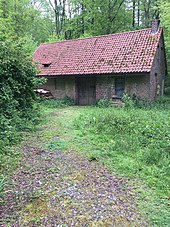Decauville Railway in the Sonienwald
| Decauville Railway in the Sonienwald | |||||||||||||||||||||||||||||||||||||
|---|---|---|---|---|---|---|---|---|---|---|---|---|---|---|---|---|---|---|---|---|---|---|---|---|---|---|---|---|---|---|---|---|---|---|---|---|---|
| Route length: | 2.5 km | ||||||||||||||||||||||||||||||||||||
| Gauge : | 600 mm ( narrow gauge ) | ||||||||||||||||||||||||||||||||||||
|
|||||||||||||||||||||||||||||||||||||
The Decauville railway in the Sonienwald ( French Chemin de fer de la forêt de Soignes , Dutch Decauville-veldspoor in het Zoniënwoud ) was a Decauville - forest railway in the Sonienwald near Brussels . The 2.5 km long narrow-gauge railway cut through Neolithic earth walls and passed two burial mounds. From 1902 until after the First World War, it transported logs and building materials for the construction of the forest roads.
Route
The route in the Sonienwald was 2.5 kilometers long. The Waldbahn, which went into operation in 1902, connected the La Petite Espinette tram stop on the Brussels tram in the municipality of Uccle / Ukkel on the border with Sint-Genesius-Rode with the Boitsfort stop on the Brussels - Namur - Luxembourg line . It began at the confluence of the Drève Saint-Hubert (fr) into the Drève de Lorraine (fr) and then followed the Drève des Deux Montagnes (fr) in a north-east direction .
The narrow-gauge railway led past the level crossing of the Chemin des Tumuli (fr) past the tumuli in the Forêt de Soignes . During the construction of the narrow-gauge railway, near the end of the line at Boitsfort, the archaeological site Bosvoorde-Vijvers was damaged, which, along with Chaumont-Gistoux-Les Bruyères and Ottenburg / Grez-Doiceau, is one of three Middle Neolithic sites in Belgium where the relief is today remains of earthworks can still be seen.
Engine shed
The engine shed was built at the same time as the line in 1902 and renovated in 2003. It served as a shed for the rail vehicles and is the only remnant of the old railway. In the 2010s, the building served the foresters and forest workers as a break room and warehouse. There is a bat quarters in the attic .
business
The narrow-gauge railway mainly carried the building materials required for the construction of the forest roads and was also used to transport logs. After the First World War it was shut down for reasons of profitability.
Individual evidence
- ↑ Stéphane Vanwijnsberghe and Jean-Christophe Prignon: Beheer plan voor het Brussels gedeelte van het Zoniënwoud. Boek III. Storage plans for archaeological sites, nature reserves and bosreservaten.
- ↑ Stéphane Vanwijnsberghe and Jean-Christophe Prignon: Plan de gestion de la Forêt de Soignes bruxelloise. Livre III. Plans de gestion des réserves archéologiques, naturelles et forestières.
- ↑ Bart Vanmontfort, Els Meirsman and Roger Langohr: Archeologische evaluatie van de neolothische site (Bosvoorde-Vijvers) Twee Bergenlaan in Watermaal-Bosvoorde.
- ↑ According to information from the Institut bruxellois pour la gestion de l'environnement.
Coordinates: 50 ° 46 ′ 38.2 " N , 4 ° 23 ′ 32" E



